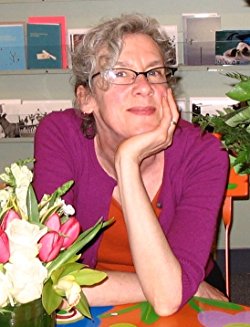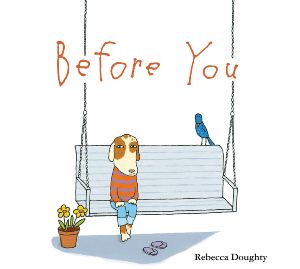 Rebecca Doughty is a lifelong painter and more recently the author and illustrator of picture books for children. The following is a complete transcript of her interview with Cracking the Cover for her latest picture book, “Before You.”
Rebecca Doughty is a lifelong painter and more recently the author and illustrator of picture books for children. The following is a complete transcript of her interview with Cracking the Cover for her latest picture book, “Before You.”
You’re a lifelong painter. When did that develop into illustration?
My artwork has taken many forms over the years, and alongside my “serious” artwork I’ve always loved to make simple comical line drawings which would end up anywhere; on a napkin, along the edges of grocery lists, on postcards, the backs of envelopes. In the late 80’s I began illustrating for a good friend who designed clothing. I made labels and hang tags, drawings of the garments, and funny cards to mail out. She and I had a similar sense of humor and I was free to have a lot of fun with the drawings. I had never considered myself an illustrator, but then about a decade later, in 1999, and completely by chance, I connected with an author who worked with fine artists to make picture books. Who knew? It was fun to have this new way to apply my style of drawing. I illustrated a number of books, learned the ropes in the publishing business, and eventually discovered I had ideas for writing and illustrating my own books.
What about writing? Did/does that come as naturally?
Yes and no. I’ve always loved to write, but I’ve never had a regular disciplined practice as I do with my artwork. I studied both art and writing in college, and first began to take writing seriously while an angst-ridden undergraduate writing poetry. But since college I have focused primarily on my artwork, except at the magical moments when the idea for a picture book has emerged. When that happens the writing comes easily, but I never know when that will be. Recently I’ve also begun writing short-short fiction, also known as flash fiction, more for an adult reader. I write fairly often, but not regularly, making notes and scribbles, kind of like little sketches, and some of them eventually become a story. I love being able to bounce around between art and writing, and it’s nice to have a number of things going at once, so if one thing has me stuck, or lost, I always have someplace else to go.
Where did the idea for “Before You” come from?
I wrote Before You for my husband, but also for everyone in my life whom I love. It took a long time to arrive! I first began working on it in 2009, and the manuscript went through lots of changes. At first it was much more for an adult reader, and slowly developed to speak to all ages. I wanted the book to be about all kinds of love and friendship.
What comes first, the illustrations or the words?
Definitely the words. For me it begins with a tiny spark of an idea, usually when I’m not trying, maybe when I’m walking, I’ll hear a line or two, a phrase or a rhyme that’s really musical, and then there’s an indescribable moment where I’m hooked, and I know I have to do it. Then the fun begins, the wordplay, and puzzling out the whole thing from start to finish. The illustrations follow, and some drawings come right away, but others take lots of trial and error.
 In “Before You,” why did you chose to use animals as opposed to people?
In “Before You,” why did you chose to use animals as opposed to people?
In this book I didn’t want to have a specific main character. Instead, I wanted this to be a love poem about anyone, and for anyone, about all kinds of love and friendship. I wanted anybody to be able to relate to the characters, whether it was a dog, or a bird, or even an ice cream cone. I thought it would be funnier and more playful to use animals and objects in the scenarios, and would leave more for the imagination. The books I loved most as a kid had animals as their main characters.
How does creating fine art differ from illustration?
Sometimes the boundary is blurry between the two, but for me the main difference is the intent, or the goal. When I paint, it’s for me, and it’s an end in itself. When I’m illustrating a book, the pictures are in a partnership and a dialog with the words they’ll accompany— they may either clarify or play off the words to expand their meaning. I also have an audience in mind when illustrating, I’m aware of how the images will be seen and interpreted. There is also, of course, a partnership with an editor and art director, and the illustrator has to be open to input and making changes. When I’m making my “fine” art I’m out there on my own, which is both daunting and great. There’s more freedom to delve in and be unsure of where the work is going. I’m tapping into a different part of myself, without filters, and I’m not thinking about the audience for the work while I’m making it.
Along those lines, does one influence the other?
Definitely, and it goes both ways. I’d been painting for many years before I ever illustrated a book, so I brought that experience and way of seeing to my books. On the flip side, I think making kid’s books has made my “fine” art more playful and comical.
Why do you think young readers are attracted to your books?
Well, I hope it’s because they seem simple, but also complicated, because kids know that life is complicated. And I hope it’s because the books are witty and not condescending, and are sweet but not saccharine. And I really hope it’s because they’re playful and funny, and have a little mischievous edge.
What are you working on now?
A few things. I have a couple of kid’s book ideas that I’ve been trying to work out; one is about companionship, written in verse and based on a famous poem. I’m having fun with that, but the other one is in story form with lots of dialog and that one is a real challenge. In my studio I’m working on some new paintings of tumbling animal characters, and I just began some imaginary portraits, painted on glass. I’m also having fun with my short stories, most recently one about having an orangutan as a housemate.
Is there a book from your own childhood that still resonates with you today?
So many. But my very favorite book, which I still have on my shelf, was Boats Finds A House, by Mary Chalmers. It’s the story of a cat who retires from working on a boat, and he’s searching for a house to live in. Along the way, with a little help and guidance, he finds out what he needs to make his house a home. This story has resonated with me all of my life in my own search for a happy home. I didn’t have a stable home as a kid and had a long road ahead of me with many twists and turns. I finally found my home twelve years ago when I met my husband. Everyone has their own Boats story about finding happiness and a sense of belonging.
